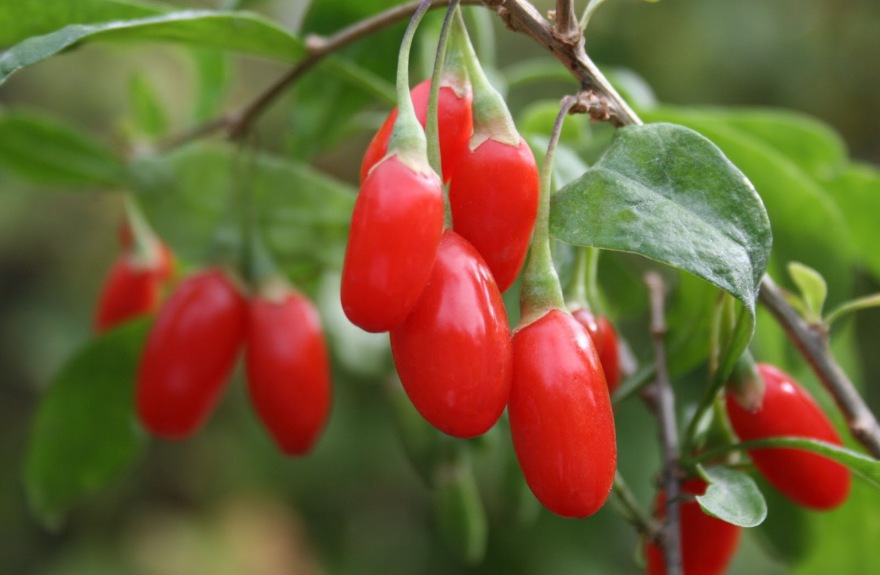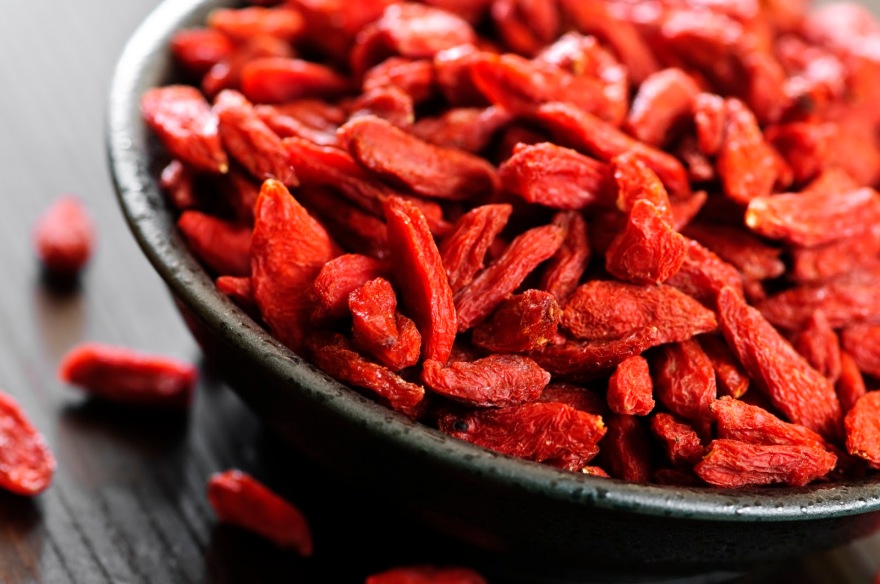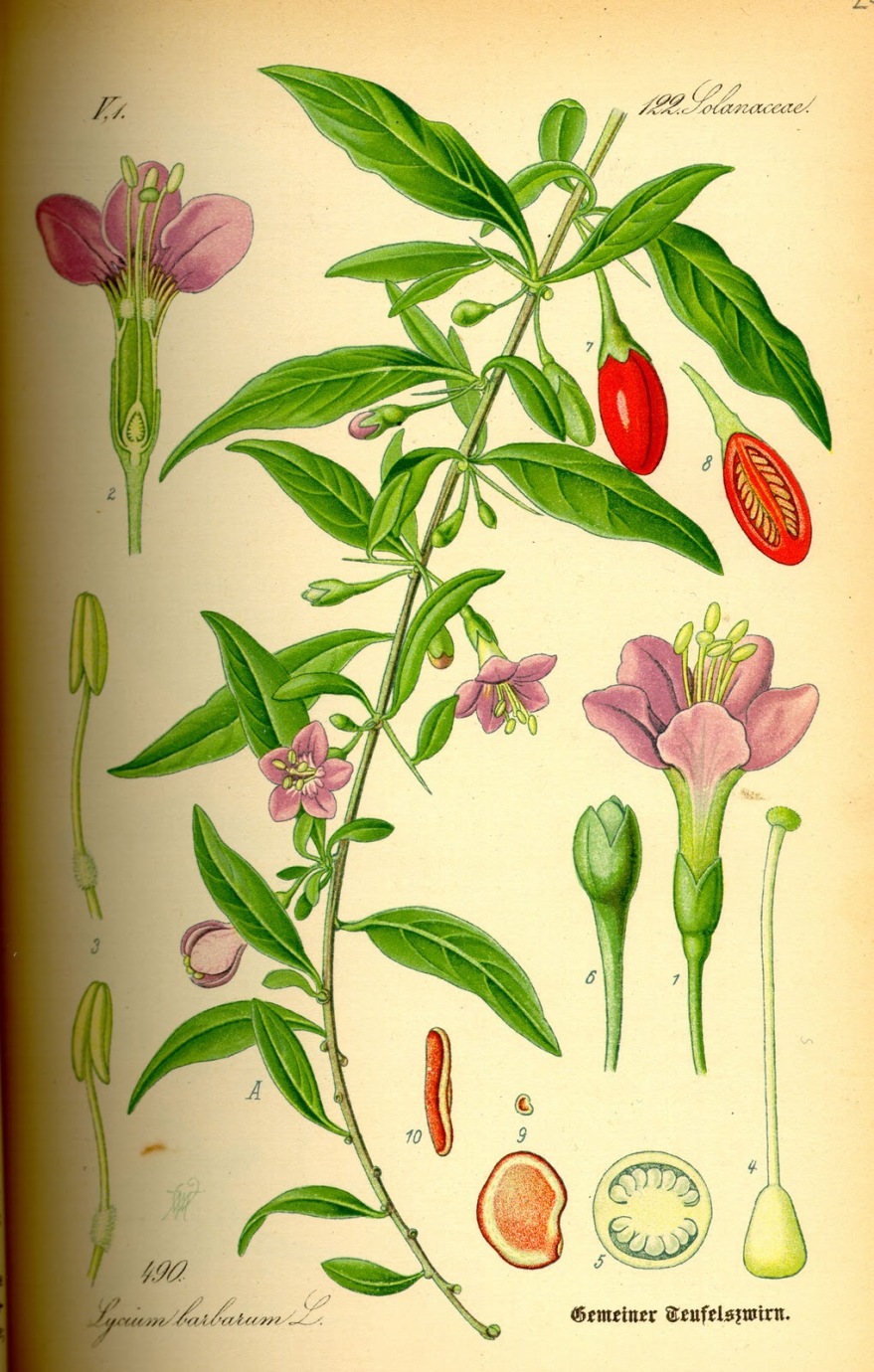 SOURCE: http://tcpermaculture.blogspot.ca/2011/12/permaculture-plants-goji-berry.html
SOURCE: http://tcpermaculture.blogspot.ca/2011/12/permaculture-plants-goji-berry.html
Scientific Name: Lycium barbarum, Lycium chinense
Common Name: Goji Berry, Wolfberry, Box Thorn, Matrimony Vine, Red Medlar, Duke of Argyll’s Tea Tree
Family: Solanaceae (nightshade)
Botanical Description:
Goji Berry (Wolfberry) plants are medium-sized, deciduous shrubs with small purple/blue flowers that produce small, bright red fruit, usually called Goji berries, or gogi berries. Goji berries are a variety of the wolfberry. The berries have high vitamin content. The shrub can grow between 2.5 to 4 meters in height. The plant flowers between June to August and the seeds ripen from August and October. The flowers possess both male and female organs (hermaphroditic) and are pollinated by bees. The plant is part of the Solanaceae – or Nightshade – family, which is related to eggplants, potatoes, tomatoes, and nightshade itself. The plant has a lifespan of 4-5 years.
Preferred Habitat:
Suitable locations for habitat include hedges, on walls, and on disturbed ground. The plant can be grown in all kinds of soils (sandy, loamy, clay), can grow in semi-shaded or shaded conditions, and can grow in maritime conditions.
Geographical Origins:
The original habitat of the goji plant is unknown at this time, but it has been speculated that it is likely from the southeastern parts of Europe or the southwestern region of Asia. Currently, Mainland China and Taiwan are the primary cultivators of commercial goji berries; however, goji berry plants are grown in most parts of the world.
Cultural / Historical Significance:
Goji berries have played an important part in traditional Chinese medicine, and have been an important staple in other medicines around East Asia. Chinese cuisine also incorporates Goji berries in a variety of soups, teas, and congees.
In the late 1990s, it was introduced into North American culture and cuisine via trade with Taiwan and Mainland China and earned the reputation as a super-food due to its high antioxidant levels. Also, despite it being considered “new” plant in North American society, it has been grown for several centuries – as early as the 1700s – in continental Europe and the UK.
Edible Uses:
The Goji berry plant has many edible uses, primarily revolving around the berries of the plant. The most common way to eat Goji berries is after they are dried, though raw and cooked berries are also acceptable once the fruits are fully ripe. When dried, they can be used for a sweet snack. The leaves of the plant can be used in teas.

SOURCE: http://tcpermaculture.blogspot.ca/2011/12/permaculture-plants-goji-berry.html
Medicinal Uses:
The plant has a long history of medicinal use, both as a general, energy restoring tonic and as a cure for a wide range of ailments. The berries are a great source of vitamins and minerals, especially Vitamins A, C, and E.Goji berries have the following medicinal effects when consumed:
Goji berries have the following medicinal effects when consumed:
- lowers blood pressure
- lowers blood cholesterol levels
- treats diabetes
- protects against liver failure
- treats poor eyesight
- treats feelings of vertigo
- treats lumbago
- helps with impotence (increases sperm production)
- relieves menopausal symptoms
- reverses cancer growth
Goji berry plant bark has the following effects if consumed or applied to the skin:
- controls cough
- lowers fevers
- lowers blood pressure
- lowers blood cholesterol level
- helps with chronic fever
- helps stop internal haemorrhaging
- prevents nosebleeds
- prevents tuberculosis
- helps with asthma
Goji berry plant leaves, when boiled into a tea, has the following effects:
- halting or reversing cancer growth
- treats inflammation
- treats skin diseases
Other Uses:
The plant can be used as a hedge and is good for soil stabilisation as the root system for the Goji berry plants are extensive.
 SOURCE: http://tcpermaculture.blogspot.ca/2011/12/permaculture-plants-goji-berry.html
SOURCE: http://tcpermaculture.blogspot.ca/2011/12/permaculture-plants-goji-berry.html
Other Fun Facts about Goji Berries
- Named the “Wolfberry” likely due to confusion about the scientific name… “Lycos” means “wolf” in Greek. “Lycium” means “originating from Lycia”, a region in modern-day Turkey.
- Ranked number one on the ORAC (Oxygen Radical Absorbance Capacity) Scale, which ranks foods with the healthy antioxidants (compounds that destroy free radicals that cause cancer and ageing).
References
Goji Berries: Origins – Consumption – Nutrition Facts – Health Benefits. (n.d.). Retrieved May 23, 2017, from http://www.nutritiousfruit.com/goji-berries.html
J. K. (1970, January 01). Permaculture Plants: Goji Berry (Wolfberry). Retrieved May 23, 2017, from http://tcpermaculture.blogspot.ca/2011/12/permaculture-plants-goji-berry.html
Lycium Barbarum Goji, Box Thorn, Matrimony Vine PFAF Plant Database. (n.d.). Retrieved May 23, 2017, from http://www.pfaf.org/user/Plant.aspx?LatinName=Lycium%2Bbarbarum
